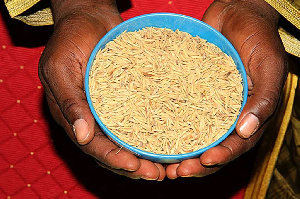Opinions of Wednesday, 18 November 2020
Columnist: Ekow Quarcoo
Fortified Rice - A basic dietary necessity
As the gatekeeper of your family’s wellbeing, you know that good nutrition is essential to a healthy life. The concept of ‘eating right’ as a treatment of chronic diseases as well as for pre-emptive health has never been more pronounced than in the present COVID-19 impacted times. Now foods positioned to support immunity or containing ingredients known to boost the immune system are thriving.
A balanced diet gives you a supply of vitamins and minerals that are essential for growth, metabolism and immunity building. The inadequate intake of these extends an open invitation to malnutrition, specifically micronutrient deficiency, which continues to be a global problem, particularly in Africa.
A different kind of hunger
Hidden hunger is a type of undernutrition that occurs when consumption and absorption of vitamins and minerals (such as zinc, iron etc.) are too low for sustaining good health and development. Factors that contribute to it include poor diet, increased micronutrient needs during life stages like pregnancy and lactation, and health problems like diseases, infections or parasites.
While clinical signs of hidden hunger, such as night blindness and goitre appear once the deficiencies become severe, the health and development of a far larger share of the population is impacted by less obvious invisible effects. That is why micronutrient deficiencies are often referred to as ‘hidden hunger’.
Women and children are usually the most vulnerable to this. According to a Micronutrient survey done in 2017 conducted by the University of Ghana in collaboration with UNICEF, about 50% of women and 66% of pre-school age children suffer from anaemia, which is most commonly caused by iron deficiency. Specifically, the study found that 30% of pre-school children suffer from this deficiency in Ghana.
The effects are devastating, leading to mental impairment, poor health, poor school performance, low productivity, and even death. Even mild to moderate deficiencies can affect a person’s mental and physical well-being.
And it is not just poverty led. Consumers are increasingly shifting from traditional diets based on minimally processed foods to highly processed, micronutrient-poor foods and drinks, which cause obesity and diet-related chronic diseases. With this nutritional transition, even families much above the poverty line can be victims to ‘Hidden Hunger’. While it may seem paradoxical, an obese child can suffer from it. While they overconsume calories, they do not consume nutrient-rich foods like beans and dark leafy green vegetables.
Solutions to hidden hunger
The role and importance of food in the treatment of chronic diseases is a concept that is increasingly attracting the interest of nutritive or dietary experts. Consumers now seek products that give strength throughout the day and give energy, allow them to focus or help them to go to sleep at night.
Diversifying diets: Increasing the diversity of food intake is one of the most effective ways to sustainably prevent hidden hunger. A variety of whole grains, legumes, fruits, vegetables, and animal-source foods provide adequate nutrition for most people. However, given today’s busy lifestyles and the limited availability of reliable and affordable sources of healthy, nutritious food, this could be difficult to achieve.
Supplementation: Supplementation can be another way to prevent nutrient deficiency but largely depends on government support in distributing the food supplements. Even with government support, the actual population coverage rates are relatively low.
Fortification of staple foods: Food fortification is the process of adding minute amounts of micronutrients to staple foods or condiments during processing and helps consumers get the recommended levels of micronutrients. A scalable, sustainable and cost-effective public health strategy, fortification has been especially successful for iodized salt: 71 per cent of the global population has access to iodized salt and the number of iodine-deficient countries in 2020 has fallen to 32 from 54 in 2003.
What’s the impact? A 2014 review of the effect of salt iodisation found that children provided with iodised salt while in the womb and during infancy and early childhood had an average IQ score of more than 13 points higher than children not consuming iodized salt. [i]
Over the past century, fortification of staple foods has played a transformational role in reducing micronutrient deficiencies, starting in the 1920s-40s in Europe and North America. Currently, in Ghana, there is legislation in place to support the fortification of wheat flour and oil. However, one staple has been largely neglected: rice.
Globally, rice fortification is mandatory in only six countries (USA, Costa Rica, Papua New Guinea, Philippines, Panama and Nicaragua), despite its evidence of reducing hidden hunger. Brazil, Colombia, Peru, Bangladesh, India and Myanmar have also introduced fortified rice with positive results, but many rice consuming countries have yet to embrace this game-changing solution.
Rice fortification to defeat nutrient-deficiency in Ghana
There is no denying that rice is one of the foremost staple foods in Ghana today. Any discussion on rice is certain to excite attention as, besides providing nourishment, it is also a source of vitamins and minerals that are essential for growth and physical wellbeing.
What then, is rice fortification? It is the process of infusing essential vitamins and minerals into rice to combat micronutrient deficiencies and help people be stronger, smarter and more productive. Simply put, it is a drive to ensure that apart from eating rice for the sake of subsistence or for sating hunger, people can also stay healthy through the rice they eat. Fortified rice is made to have adequate doses of key nutrients that help the body to fight off deficiencies and diseases.
Today, Ghana needs to key into this drive to ensure rice fortification. If not for anything else, the need to ensure that children and youth reach their full potential by eating healthier food as a defence mechanism against malnutrition is compelling.
For example, information gleaned from the Ghana National Nutrition Policy 2013-2017 showed that anaemia rates are high among children below five years of age in the Upper East (89%), Upper West (88%) and Central regions of Ghana (85%). Equally important to note is that Ghana is on the list of countries with a high burden of malnutrition in the world. The 2008 Lancet series in nutrition classified Ghana among the 36 countries with a high burden of chronic childhood nutrition deficiency.
In this light, it is most gratifying to learn that rice fortification may very soon be a Ghanaian phenomenon as the concept has now been embraced by one of the key players in the rice sector. Olam Ghana has announced that it is ready to launch a fortified version of its popular premium long-grain rice brand –Royal Aroma Fortified Rice.
Royal Aroma Fortified rice has iron, the deficiency of which causes anaemia. It also has zinc which boosts immunity. Vitamin B3 (Niacin), B6 (Pyridoxine), B9 (Folate) and B12 (Cobalamin) which are present in it contribute to various health and wellness factors ranging from maintaining healthy skin, production of enzymes and making new red blood cells to generating DNA and genetic material.
There is no doubt that the philosophy behind fortified rice is aimed at promoting a healthy citizenry through the receipt of a good dosage of nutrients (15% of RDA per serving), necessary for body metabolism. A healthy citizenry helps promote a robust economy and a better country in all respects. There is so much to gain for the country in promoting this novel initiative.











